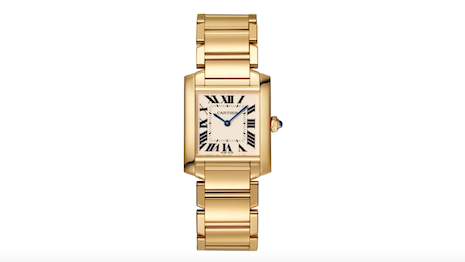 Cartier's Tank Française is an updated look from the legacy of the Tank wristwatch with a chain-link bracelet. It is instantly recognizable as the product of its manufacturer. Image credit: Cartier
Cartier's Tank Française is an updated look from the legacy of the Tank wristwatch with a chain-link bracelet. It is instantly recognizable as the product of its manufacturer. Image credit: Cartier
Successful designs can be invaluable to a brand. From the Birkin bag, to the Tank Française watch to the Alhambra jewelry pendant, these iconic designs have made millions for their brands, and are instantly recognizable as products of their manufacturers.
But what protects these designs from knockoffs and piracy? Copyright and design patents are two answers, and I have written about them before (“Must-know basics of copyright law for the luxury business” and “Must-know basics of design patent law for fashion and luxury goods”).
But a third form of protection, trade dress, is something luxury goods companies need to understand.
Trade dress can be a very powerful form of protection, but only if a company understands how to gain and maintain it.
So, here are the 10 basic things you need to know:
Trade dress is a kind of trademark
Trade dress is a subset of trademark law and has all the requirements and details of that law. I previously wrote about the basics of trademark law (“Must-know basics of trademark law for the luxury business”), so I will not repeat that here.
Trade dress refers to protection of designs that function as a trademark. The design itself is associated with a single source and identifies the product as from that source.
The most famous example of trade dress is the Coca-Cola bottle. Anyone who sees that shape, even without seeing the words “Coca-Cola,” instantly recognizes the bottle as from that company.
Trade dress can protect designs of products, portions of products, and packaging.
Trade dress requires “acquired distinctiveness”
As I previously wrote, every trademark has to be “distinctive,” which means that they differentiate the goods of one producer from another.
Some trademarks are inherently distinctive, such as arbitrary words that have no inherent connection to the product.
The term APPLE has nothing to do with computers or smartphones, so its use as a mark for those products is completely arbitrary.
Such a trademark will be immediately protected once a company commences use of it to identify products.
Other trademarks only become distinctive by building up commercial recognition, termed “acquired distinctiveness” (oftentimes called “secondary meaning”).
WINDOWS, for example, describes a computer operating system that displays windows on the screen so that the user can interact easily with the computer.
So initially, such a trademark would not be protected under trademark law.
But the company selling that software has built up that name so much, that it is now identified with a single source, and thus has achieved “secondary meaning.”
In 2000, the U.S. Supreme Court ruled that product design can never be inherently distinctive.
Rather, the owner has to show that through sales and promotion the consuming public has come to associate that design with only one producer.
So, the public’s perception becomes even more important in trade dress cases. The key question is, does the consuming public view the design and associate it with only one source?
The relevant public is the product consumer base
The “acquired distinctiveness” has to be among the public that purchases those products. For general consumer goods, this means almost everyone.
For luxury goods, however, the relevant universe is narrower – those likely to buy those products.
Most consumers are not in the market for a $25,000 watch or a $15,000 handbag. So, the “acquired distinctiveness” can be limited to that market segment. This is often the case for luxury goods, which are marketed to an upscale audience.
Advertising should emphasize product design
One major way to build recognition and association in a design is through advertising and promotion. And a key part of that is emphasis of the design.
In one of our trade dress litigations, the chairman of a famous luxury goods company explained that there are two schools of thought as to what to emphasize in advertising: product advertising and lifestyle advertising. His company favored product advertising – which emphasizes the look of the product, and the brand name. A typical advertisement would show both, and thus reinforce the association of the look of the product and the brand.
This kind of advertising is generally the most effective in building trade dress rights.
Maintaining sales and advertising records is important
Sales, advertising and promotion are the principal forms of proof that a design has achieved “acquired distinctiveness.”
So, it is crucial that the brand maintain good records of its sales of the product, the appearance of all design variations (e.g., catalogs), and all advertising and promotional efforts. That would include, for example, schedules of media placements and spends, and examples of advertising used in various campaign.
Other promotional efforts might include charity events and sponsorships; trade events; Web site and social media promotions; and product tie-ins.
All of these can be valuable to create association of the product design with the brand.
And for all of these, records are crucial – how much was spent, how widely received was the promotion, and what were the visuals used – should be maintained as records that can be used to prove acquired distinctiveness.
Media comments: Another excellent source of proofs
Comments by the media about the product can also be excellent sources of proof. Better yet, articles that feature pictures of the product reinforce the brand association.
The best are articles that make comments about how well recognized the product is.
Articles that state that the design is “iconic,” “instantly recognizable” or a “classic that everyone must have” are worth their weight in gold to prove acquired distinctiveness.
Many luxury brands have a media office that collects and keeps records of every mention of the brand and brand product in the media. This might include the general media as well as specialized product periodicals.
Indeed, this is an excellent practice that makes it easier to prove acquired distinctiveness.
Enforcement and maintaining exclusivity
Exclusive use of the design is critical to developing and maintaining distinctiveness. If five other brands sell the same design, then it obviously is not associated with a single brand.
One important part of that is enforcing against knockoff artists and pirates.
An enforcement program goes a long way to show that the brand is maintaining exclusivity. This might include takedown services directed at the Internet and selling platforms such as Amazon, cease-and-desist letters and settlements, and litigation.
As always, good records of these efforts, and how much piracy has been stopped, are important.
Pirates, by the way, can often also be a good source of proofs of acquired distinctiveness.
In one case we litigated, the pirates had advertised their knockoffs – that copied our client’s design, but not its brand name – as “Brand X Style.” That certainly was powerful proof that that the product design was associated with Brand X – even the pirates said so.
Trade dress designs cannot be functional
One major limitation on trade dress protection is that it cannot be “functional.” This does not mean that the article performs a function.
Watch, handbag, and clothing designs all perform a function, but they can still be protected as trade dress.
Rather, “functional” means that the design gives some competitive advantage, apart from association with the brand.
The primary form of that is called “utilitarian functionality.”
If the design makes the article work better, easier to use, or cheaper to manufacture, then it is functional – and that is an absolute bar to trade dress protection.
For example, luminous numeral markings on a watch are functional – they make it easier to tell time in the dark. So that cannot be a trade dress for a watch design.
One way functionality can be shown is through the producer’s advertising.
If you brag that the product design of your article makes it work better, then that could be used against you in a trade dress case.
Note, however, that for the superior quality to render the design “functional,” the superiority has to be tied to the design.
The fact that a manufacturer brags that it puts out a high-quality product by itself does not render the design functional.
Many designs for the same product can be manufactured in various degrees of quality, from excellent to poor.
What makes a design functional under trademark law is where the design itself makes the product superior in some way to the alternatives.
The other form of functionality is “aesthetic functionality.” This means that something about the design is needed to compete.
For example, a decorative design for room furnishings is needed to match standard features used in interior decorating.
Most luxury goods products do not have functionality issues.
One powerful proof of non-functionality is availability of alternative designs. Typically, there are hundreds of designs on the market for the same type of product: a handbag, watch, or clothing item. That competitors have so many alternatives to compete shows that the design is not needed to make a better product.
Trade dress can be registered
Like any trademark, trade dress can be registered with the United States Patent and Trademark Office, and that confers certain advantages on the trademark owner.
The Trademark Office, of course, scrutinizes the application to see that it meets all the requirements for trade dress, including acquired distinctiveness and non-functionality.
Some illustrative examples of registered trade dress are shown below.
As discussed, trade dress can be claimed and registered in part of the design of an article.
The drawing in the registration will show the rest of the article in dotted lines, and the registration will then state that the dotted part is not part of the claimed trade dress, but merely illustrates the position of the claimed part.
Other forms of intellectual property can be used
Trade dress rights are not exclusive of other rights.
The same design protected by trade dress could also be protected by copyright or design patent, assuming the requirements of those laws can be met.
A strategy that many luxury goods and fashion companies use is to first use copyright or design patent to secure exclusivity in a design, and then use that period of protection to build up acquired distinctiveness.
TRADE DRESS can be a very powerful form of protection.
Unlike design patents or copyrights, trade dress rights potentially may last forever.
Once achieved, they can be used both against competitors to maintain exclusivity and pirates who try to take unfair advantage of brand success.
Understanding the legal requirements for gaining these rights is the first step for brands protecting their designs through this body of law.
 Milton Springut is a partner at Springut Law PC
Milton Springut is a partner at Springut Law PC
Milton Springut is a partner at Springut Law PC, New York. Reach him at [email protected]. Mr. Springut's opinions are solely his.
